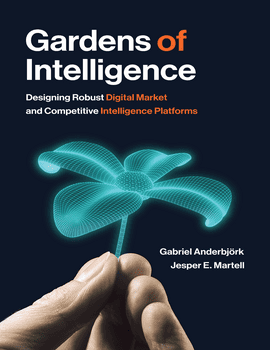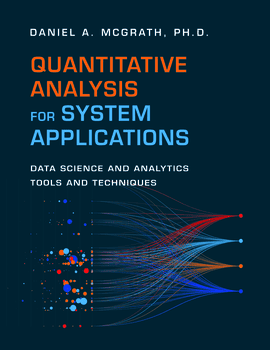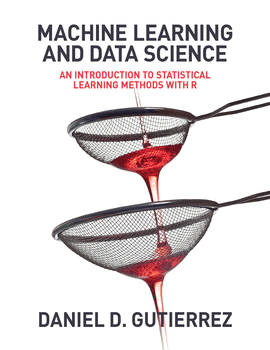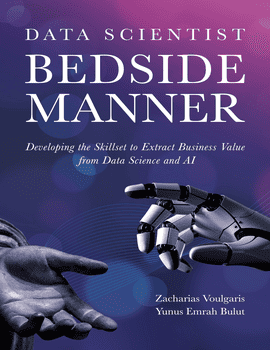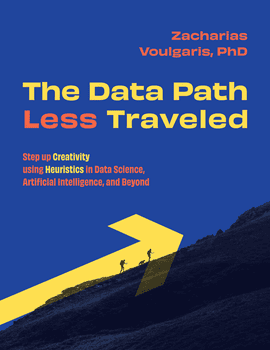Gardens of Intelligence
Gardens of Intelligence: Designing Robust Digital Market and Competitive Intelligence Platforms, by Gabriel Anderbjörk and Jesper Ejdling Martell
“When the future knocks on the door, it never walks away.”
Topics
Part I: Wild Grown Landscape
Chapter 1: Introducing Market and Competitive Intelligence (MCI)
Key MCI drivers
Decision-making requires intelligence
The business impact of MCI
MCI capabilities
MCI versus business intelligence
The traditional intelligence cycle
Success patterns and pitfalls
Convincing executives to invest in MCI
Key takeaways
Chapter 2: Everything is Changing!
The intelligence cycle is changing
The competitive landscape is changing
The workforce is changing
The role of MCI professionals is changing
The users and producers of intelligence are changing
The technology of MCI is changing
Key takeaways
Part II: Growing a Garden
Chapter 3: Preparing the Grounds
The phases and levels of growing a Garden of Intelligence
The Information, Technology, People (ITP) framework
The team of gardeners
Key takeaways
Chapter 4: The Six Levels of a Garden of Intelligence
Locating: Evolving to Level 1—The Seeds
Planting: Evolving to Level 2—The Sprouts
Cultivating: Evolving to Level 3—The Plants
Spreading: Evolving to Level 4—The Flower Beds
Burgeoning: Evolving to Level 5—The Shrubberies
Harvesting: Evolving to Level 6—The Blooming Garden
How much time will it take?
Key takeaways
Part III: Digging Deeper
Chapter 5: Navigating Information in a Structured Way
Jungles of information
Structured information management and data governance
Taxonomies—A widely used tool for classification
Content-driven taxonomies
Context-driven taxonomies
Developing a context-driven taxonomy
Adding process and assessment classification
The battle between manual and automatic classification
Benefits of classification
A visual example
Key takeaways
Chapter 6: Selecting Relevant Information Sources
Segmenting information sources
External sources—open
External sources—commercial
Internal sources—observers and subject matter experts
Internal sources—content
Creating the right source mix
Structuring your information needs
Continuously tuning your source mix
Key takeaways
Chapter 7: How to Build a MCI Technology Platform
What is a MCI technology platform?
Do you really need a MCI platform?
Monitor and discover
How do technology platforms support MCI?
Be part of an enterprise eco-system
Checklist for evaluating a MCI platform
Main challenges in deploying MCI technology
Key takeaways
Chapter 8: How to Apply Artificial Intelligence and Machine Learning Technology
The new digitized world
Disrupting the intelligence world
Introducing AI and ML
So, what is an algorithm?
Applying machine learning to intelligence challenges
Use cases of machine learning
Machine learning risks
Will machines replace humans?
Towards augmented intelligence
Challenges with augmented intelligence applications
Key takeaways
Chapter 9: How to Create an Intelligent Community of People
Defining an intelligent community
The intelligent community and its operations
Managing intelligent communities—Information resources
Managing intelligent communities—Human resources
Managing intelligent communities—Methodologies
Using incentives to encourage participants
Key takeaways
Chapter 10: How to Prepare People for Change and Disruption
Scenario planning
Business war games
Trend radars
Early Warning (EW) systems
Innovation management
Key takeaways
Part IV: Beyond the Garden Walls
Chapter 11: Becoming a Healthier Organization
Healthier decisions
Healthier market position
Healthier ways of working
Heathier financials
Healthier future
Measuring the value
Key takeaways
Chapter 12: Inspirational Cases
INFORMATION CASE: A manufacturing company
INFORMATION CASE: A global technology company
TECHNOLOGY CASE: The Intelligence2day®
TECHNOLOGY CASE: Netflix
TECHNOLOGY CASE: A global law firm
PEOPLE CASE: Ericsson
PEOPLE CASE: An energy company
Market and Competitive Intelligence (MCI) is the process of enhancing marketplace competitiveness through a greater understanding of a firm’s competitive environment as well as leveraging the capabilities of preparedness for the future.
What if you could:
- Spend more time creating forward-looking actionable intelligence, thanks to smarter tools?
- Collaborate better and develop hypotheses that can be tested and validated by data analysis?
- Become more in line with future market expectations as predictions are more accurate?
- Use human analysis to put information into context, ask relevant questions, and create the best algorithms for machines?
This book digs deep into the challenges and opportunities of how to succeed with technology platforms for market and competitive intelligence.
The authors draw on their extensive experience and real-life cases to present their “Garden of Intelligence” framework. These insights will make your organization healthier and more fit to reap the benefits of opportunities and handle disruptions in the future.
With this book, we aim to bring intelligence into the future and the future into intelligence.
Watch the book release celebration!
About Gabriel and Jesper
Gabriel Anderbjörk is CEO of Inzyon and a true innovator and entrepreneur within the fields of Information Management, Knowledge Management, and Enterprise Intelligence. Since his role as corporate director of CI at telecommunications vendor Ericsson, his professional experience spans more than 25 years and includes numerous major projects worldwide.
Jesper Ejdling Martell is CEO of Comintelli and a highly experienced Competitive Intelligence (CI) professional, having worked in the field since 1996 at which time he managed the corporate Business Information Centre at telecommunications vendor Ericsson. Over the years, Jesper has served as a trusted advisor in CI-related matters for various multinational organizations.
Faculty may request complimentary digital desk copies
Please complete all fields.
